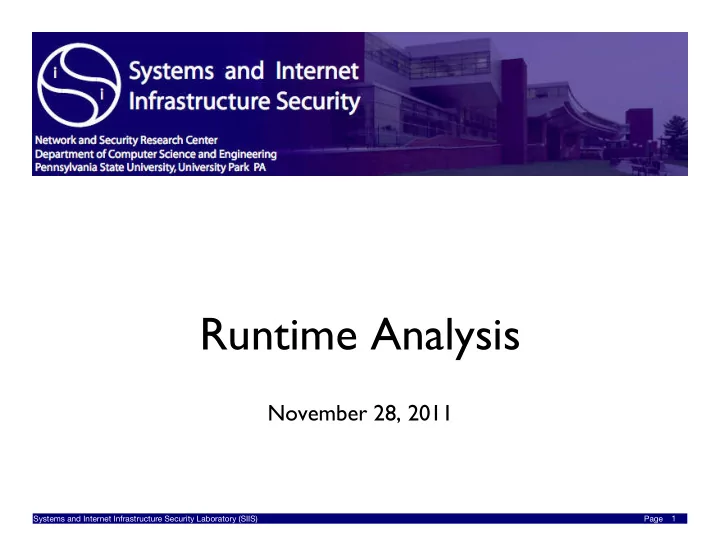

Runtime Analysis November 28, 2011 Page 1 Systems and Internet Infrastructure Security Laboratory (SIIS)
Analysis So Far • Prove whether a property always holds ‣ May analysis • Prove whether a property can hold ‣ Must analysis • Key step: abstract interpretation to overapproximate behavior of program • But, it can be expensive and complex Page 2 Systems and Internet Infrastructure Security Laboratory (SIIS)
Runtime Analysis • Collect traces of program runs to evaluate a property • Testing ‣ Run test cases to determine if property holds (or fails to hold) in all cases ‣ Inherently incomplete • Traces ‣ Compare several runs to determine if a property holds across runs ‣ Incomplete? Page 3 Systems and Internet Infrastructure Security Laboratory (SIIS)
Example • Runtime Verification of Authorization Hook Placement for the Linux Security Modules Framework • Linux Security Modules (LSM) framework • Problem: Are authorization hooks placed correctly? ‣ What does that mean? Page 4 Systems and Internet Infrastructure Security Laboratory (SIIS)
Mediation • Security-sensitive Operations : These are the operations that impact the security of the system. • Controlled Operations : A subset of security-sensitive operations that mediate access to all other security- sensitive operations. These operations define a mediation interface. • Authorization Hooks : These are the authorization checks in the system (e.g., the LSM-patched Linux kernel). • Policy Operations : These are the conceptual operations authorized by the authorization hooks. Page 5 Systems and Internet Infrastructure Security Laboratory (SIIS)
Mediation Overview 6 Systems and Internet Infrastructure Security Laboratory (SIIS) Page
Security-Sensitive Ops • What code-level operations indicate security- sensitivity? • Variable access? • Structure member access? • Global access? Page 7 Systems and Internet Infrastructure Security Laboratory (SIIS)
Key Challenges • Identify Controlled Operations : Find the set of security- sensitive operations that define a mediation interface • Determine Authorization Requirements : For each controlled operation, identify the policy operation • Verify Complete Authorization : For each controlled operation, verify that the correct authorization requirements (policy operation) is enforced • Verify Hook Placement Clarity : Controlled operations implementing a policy operation should be easily identifiable from their authorization hooks Page 8 Systems and Internet Infrastructure Security Laboratory (SIIS)
Key Relations predicts mediates defines mediates 9 Systems and Internet Infrastructure Security Laboratory (SIIS) Page
Analysis Approach • Check consistency between hooks and security- sensitive operations ‣ Traces • Sensitivity ‣ Structure member accesses ‣ Hooks • Consistent relationship indicates hook is associated with SMAs (make a controlled op) ‣ Sensitivity can vary in granularity Page 10 Systems and Internet Infrastructure Security Laboratory (SIIS)
Sensitivities 11 Systems and Internet Infrastructure Security Laboratory (SIIS) Page
Anomalies • For SMAs to be a controlled op ‣ Path: all traces with SMA should have same hooks • Not dependent on paths taken to get there ‣ Function: all traces with same SMA type in same function should have same hooks • SMA in function defines controlled op if always associated with hook Page 12 Systems and Internet Infrastructure Security Laboratory (SIIS)
Implementation • Propose sensitivity rules for system call processing ‣ Propose relationship between hooks and controlled ops • Log traces of system call processing ‣ Collect syscall entry/exit/args, function entry/exit, controlled ops, and hooks • Compute whether hooks always/sometimes/never in trace for each controlled op ‣ Evaluate whether the current sensitivity rules express the expected consistency • Update sensitivity rules Page 13 Systems and Internet Infrastructure Security Laboratory (SIIS)
Implementation 14 Systems and Internet Infrastructure Security Laboratory (SIIS) Page
Logging • Authorization hooks ‣ LSM itself • Controlled operations (SSOs) ‣ GCC module • Control data ‣ GCC flag • System call contexts ‣ Kernel scheduling loop Page 15 Systems and Internet Infrastructure Security Laboratory (SIIS)
Log Filtering Rules • For sensitivity ‣ Filter log entries processed to determine sensitivity Page 16 Systems and Internet Infrastructure Security Laboratory (SIIS)
Log Filtering Rules 17 Systems and Internet Infrastructure Security Laboratory (SIIS) Page
Results • Missing hook ‣ Setgroups16 • Have different numbers of hooks ‣ Fcntl (set_fowner) • Missing hook ‣ Fcntl (signal) • Missing hook ‣ Read (Memory mapped files) Page 18 Systems and Internet Infrastructure Security Laboratory (SIIS)
Runtime Analysis • Choose test cases • Collect traces (content of traces) • Analyze traces • Evaluate property Page 19 Systems and Internet Infrastructure Security Laboratory (SIIS)
Hook Placement • A variety of analysis for hook placement and testing • Zhang [USENIX 2002] • Ganapathy [CCS 3005, Oakland 2006, ICSE 2007] • Tan [USENIX 2008] • [AsiaCCS 2008] • Son [OOPSLA 2010] • King etal [ESOP 2010] • We are working on a purely static analysis Page 20 Systems and Internet Infrastructure Security Laboratory (SIIS)
Recommend
More recommend